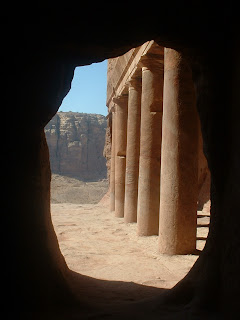



OK, this is not a particularly accurate title because I've been too busy on this trip to do much sight-seeing. That said, if you come to Jordan, and you should definitely come to Jordan - in fact, I would love to bring some students over here on a cultural immersion trip - there are a million things to do. Amman itself is great, with loads of history (the Citadel is located right downtown, next to the Roman theatre, and it has been occupied over the centuries by Romans, Byzantines and Umayyads) as well as stores so modern you would think you were in Paris. Jerash provides some of the best preserved Roman ruins in the world. Umm Qais also has great Roman ruins, and is not nearly as crowded as Jerash because it is tucked away in the northwest corner of Jordan, but is also the location where Jesus is supposed to have driven the evil spirits out of the possessed man and put it in a herd of swing that jumped off a cliff - surprisingly, when I went there a couple years ago I felt fine. The Dead Sea is OK, mainly for the experience of floating in it, although it's way too pricey for my blood - it is a neat place to watch the sun go down over the mountains in Israel, partially because it looks strangely like the sun going down over the New York mountains as seen from Burlington. You can go to Bethany Over Jordan where it is believed, at least by the Jordanian tourist industry, that Jesus was baptized. You can also go to Madaba to look at more mosaics than you could probably stand, and get a shave if you want for on dinar. The desert castle at Azraq is great, especially if you're up on your Lawrence of Arabia lore. I had my ultimate nerd moment there, which is saying something because my life is one long unbroken string of nerd moments. On my first trip to Jordan I was reading Lawrence's Seven Pillars while riding around on the bus with a dozen others professors on a grant to study Middle Eastern culture. When we stopped in Azraq I read, aloud, to the other professors, Lawrence's account of the room he stayed in at Azraq in the very room - including his account of ghosts - in any other line of work I would have been beaten to a pulp, but the other professors were delighted. I had a really profound moment at Mukawir, which was a Jewish fortress on a hill that was eventually taken over by the Romans. It was where Salome danced and John the Baptist had his head chopped off. I was standing up there next to Roman columns while the sun was going down, and the lights of Jerusalem were starting to twinkle, and the Islamic call to prayer started at two different mosques on neighboring hills. It was really emotional. So, a million things to do, although that really wasn't an option this time.
The one huge exception this time was a return trip to Petra. It was a Saturday so university meetings were out of the question. It's about a three hour drive from Amman to Petra if you take the more boring modern road, as compared to around five hours if you take the king's highway. It only took about two and a half hours because the taxi driver was going around 160 kph, which, if you convert kph to mph, converts to really fast. When you think of Petra the first thought for most Americans is the end of the third Indiana Jones movie (and, actually, there is a little gift shop right at the entrance called the Indiana Jones Gift Shop). Certainly, travelling through the Siq and coming out to the Treasury is one of the most amazing moments that you'll ever experience. However, that is just the beginning - Petra is huge. You can walk around for seven or eight hours and still just be scratching the surface. At the end of the day you can walk up the 850 steps to the Monastery at the top of the mountain, which is even bigger than the Treasury. If you go a little further you come to the shop at the end of the world - these merchants carry their wares up to the edge of the cliff overlooking the Wadi Arabia, and it's almost a contest to who can come closest to the edge. Many of the merchants actually still live in the caves of Petra. There is also a massive temple in the center of Petra and endless Nabatean tombs. This time for the first time I climbed up to the High Place of Sacrifice which is on a different cliff. Exhausting, but absolutely amazing. Petra is one of those places that you see and then you can't quite convince yourself that you were there. At the end of the day I got the money shot - a Bdul riding a camel on a Roman road with Nabatean tombs in the background.















